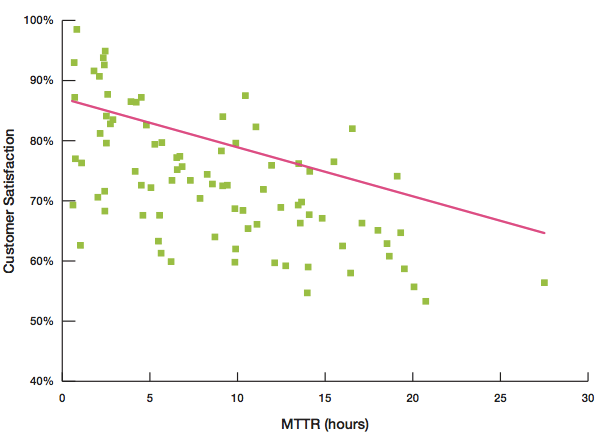How to create a service level agreement that helps retain customers

Measuring and analyzing workflows can streamline approaches to how a company manages its key processes. When it comes to managing a service desk, companies often want to streamline how they provide service to their customers. This could be in the form of answering customer requests or making sure requests get resolved correctly and in a timely manner.
Consequently, to resolve customer requests correctly and in a timely manner companies should establish and keep track of metrics.
MSP Service Level Agreement 1: TIME TO FIRST RESPONSE
One critical factor in running a high performing service desk is responsiveness. Customers want to know that you will be responsive to their requests even if it is understood that a complete resolution will take a few days. One way to measure this is with a Time to First Response metric.
Time to First Response is the time it takes from the moment a customer makes a request to the time a help desk agent “picks up” the ticket and begins to read it. What does “picks up” mean? A ticket should be considered “picked up” when a service desk agent opens the ticket and begins reading it. The act of opening the ticket should place it in a workflow status equivalent of “In Progress.” In other words, the service desk agent should understand that once they open the ticket and begin reading it, the customer is notified.
Notifying the customer is part of what makes this metric a measure of responsiveness. A customer should be able to view the request to see it’s current status, and when that status shows that the ticket is “In Progress,” the customer knows someone has started working on it. The customer sees this and is immediately comfortable that someone opened the ticket and has, at least, begun. A high performing service desk places a high level of importance on communicating current status of a ticket so customers know where it stands at all times.
MSP Service Level Agreement 2: TIME TO RESOLUTION
It is important to be speedy in your first response to a customer. Customers do want to know that you are responsive. However, what the customer really wants is for their issue to be resolved in the most efficient manner possible. A high performing service desk should measure Time to Resolution, which is the total time it takes to resolve an issue. Although this metric seems quite simple, there are some nuances to consider:
- What happens when an issues requires further input from a customer?
- Do you count the time that a ticket spends waiting for a customer to respond?
- What if a service desk agent requests more information from a customer and what if the customer takes four days to respond. Should those four days waiting for the customer count against the service desk agent?
This is not as easy to answer as it seems because on the surface, you would not want to count the time waiting for customers to respond against the service desk metrics. However, there are managers that believe it doesn’t matter who is waiting for whom. If a ticket is opened, it is not resolved. Furthermore, everything that happens in between “Created” and “Resolved” matters to how long it takes to resolve an issue. The point is to define Time to Resolution in a way that matches your culture and to find a tool that is flexible enough to handle how you want to define and measure it.
WHY DOES TIME TO RESOLUTION MATTER?
Time to resolution directly correlates to customer satisfaction (see the chart below). The quicker your team is able to resolve problems for customers, the happier they will be. If you take too long to resolve their issues, customers will become upset. According to many customer service statistics, they may even take their business elsewhere.
Chart showing the correlation between time to resolution and customer satisfaction.

Fig1
Time to resolution also reflects your team’s efficiency. Analyzing time to resolution will show how effective your team’s process is. You should also keep an eye on any trends you notice within this metric. If your time to resolution is increasing over time, you know something is wrong. Similarly, if you see a sharp decrease in time to resolution without any strategic changes to the team, you may have a quality control issue.
Tracking your time to resolution will help measure your team’s overall performance. If your time to resolution is longer than you’d like it to be, you should find out why that is. By breaking down this metric, you’ll be able to pinpoint weaknesses, strive to improve, and, ultimately, make more customers happier.
HOW SHOULD TIME TO RESOLUTION BE ANALYZED?
To really dig into the analysis and get a more granular look at the data, you should look at time to resolution by employee . This will allow you to see which incident responder are more efficient than others, and which incident responder need more coaching and training.
Consider this: an incident responder who has a significantly higher time to resolution than all of the others is a person who could be holding back the team. In this case, you would want to find out why this rep is taking a relatively long time to resolve cases. What are they struggling with? Maybe they need some coaching to help them get up to speed.
On the flip side, if incident responders are able to resolve cases faster than everyone else on the team. Chances are, the other incident responder could learn a thing or two from them. In this case, you would want to ask the top-performing incident responder about how they are able to resolve cases so quickly. Pick their brains, find out what’s working well for them, and share their insights with the rest of your team.
To read more tips download the white paper







